

The
Research Project
The Study Area
Background Information
Tools Of The Trade
A Day In The Life Of . . .
Monday, December 10, 2001
Animal Rescues
 This
morning while Lindsay, Samuel and Kevin were on a monkey survey, they rescued
a baby woodpecker. It had fallen from its nest and gotten tangled in some
tree limbs. Barely alive, Lindsay brought it back to camp where there was
a discussion about whether the most humane thing to do would be to kill
it quickly given that it was probably going to die anyway.
This
morning while Lindsay, Samuel and Kevin were on a monkey survey, they rescued
a baby woodpecker. It had fallen from its nest and gotten tangled in some
tree limbs. Barely alive, Lindsay brought it back to camp where there was
a discussion about whether the most humane thing to do would be to kill
it quickly given that it was probably going to die anyway.
Lindsay decided to try and keep it alive. She wrapped it in towels and fed it a mixture of crushed insects and peanut butter. By this evening it was hopping around her cabin, although its back leg appears to still be swollen. With luck it may live.
Later in the afternoon, we had a rainstorm with thunder and lightening. After one particularly loud clap of thunder, the two resident duikers at Exploration Camp scattered into the forest for shelter.
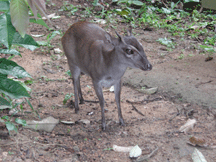 After
the rain we noticed that the male had come back out of the forest, but not
the female. We wondered where the female was, since they are never apart.
After
the rain we noticed that the male had come back out of the forest, but not
the female. We wondered where the female was, since they are never apart.
Later that evening, we started to walk the half-mile from the Exploration Camp to the Research Camp for dinner. About half way up the road, the female came bounding out of the field to greet us. Apparently when they ran for cover during the storm, they got separated. As we continued to walk she followed us. Thinking she would never find her way back, we decided to walk her back to Exploration Camp to reunite her with her partner. It was funny to see her following us. They are so small, and even though we walked slowly, she had to run to keep up with us, much like a puppy. It took close to 15 minutes to walk the .25 mile back to camp.
Once there, we couldn’t find the male. Since it was twilight, we figured he had retreated back to the forest for the night. Now we faced a dilemma! The female would not leave our side and we needed to get back to camp. If we walked up the road again, she would follow us for sure. After debating about what to do, we decided to walk as fast as we could, knowing she could not possibly keep up with us. It seemed to work as we lost her shortly. We will see tomorrow if they manage to find each other during the night.
Lindsay’s Bush Baby
We wrote before how Lindsay’s truck got its name, "Bush Baby". Last night Lindsay told us how she actually raised the bush baby for 3 months before it ran away.
After Lindsay and George found the baby monkey in the back of the truck, Lindsay kept it in her cabin and fed it insects. Eventually she taught it to catch its own food. Lindsay would catch live grasshoppers and release them in her room during the day. The monkey would spend the night (they are nocturnal) catching them all. Lindsay said she eventually learned to sleep through his nightly shenanigans. Early each morning, after his nightly "activities" he would curl up in the crook of her neck and shoulder and fall fast asleep.
One day the door to her cabin was open and he ran away into the forest. Since she taught him to catch bugs, there is a chance he will survive. It is always a dilemma when finding animals in the wild that need help. If you help them, you then have to be responsible for them.
Bamboo Cathedral
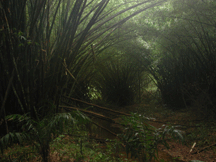 Very
close to Research Camp, there is an enormous clearing in the forest that
contains only bamboo trees. Nobody knows how they got there, but they call
it the Bamboo Cathedral. The bamboo grows in humungous clumps and each clump
arches up and over the area. It is a very beautiful and unusual area—almost
magical!
Very
close to Research Camp, there is an enormous clearing in the forest that
contains only bamboo trees. Nobody knows how they got there, but they call
it the Bamboo Cathedral. The bamboo grows in humungous clumps and each clump
arches up and over the area. It is a very beautiful and unusual area—almost
magical!
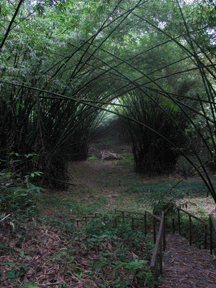 Linking
this “cathedral” to the jungle are paths and bridges made of bamboo. Because
of the bamboo growing here many things in the reserve are constructed of
bamboo as it grows so quickly and is a durable wood for building. What is
interesting is that many companies in the United States are using bamboo
as an alternative to hardwood, as hardwood is getting scarce and takes many
years to grow to maturity.
Linking
this “cathedral” to the jungle are paths and bridges made of bamboo. Because
of the bamboo growing here many things in the reserve are constructed of
bamboo as it grows so quickly and is a durable wood for building. What is
interesting is that many companies in the United States are using bamboo
as an alternative to hardwood, as hardwood is getting scarce and takes many
years to grow to maturity.
Poachers, Snares and Empty Cartridges
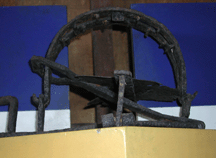 We
have finally transcribed all of Lindsay’s monkey data. You will want to
visit the Daily Data section to review it, as it is
very interesting. Talking about it this evening with Lindsay was a bit depressing.
So many of the comments she made on the data sheet while on the transects,
are about the evidence of poaching. Everything from snares, traps and empty
shotgun cartridges to poacher camps and even poachers themselves are noted.
We
have finally transcribed all of Lindsay’s monkey data. You will want to
visit the Daily Data section to review it, as it is
very interesting. Talking about it this evening with Lindsay was a bit depressing.
So many of the comments she made on the data sheet while on the transects,
are about the evidence of poaching. Everything from snares, traps and empty
shotgun cartridges to poacher camps and even poachers themselves are noted.
While a tremendous effort is being made to protect these areas, they are still heavily hunted. One day they found up to 40 traps along the side of their trail—and all of this in a protected reserve. Many of the poachers merely hunt to provide food for their families, but some are also gathering meat and other materials to sell in the markets.
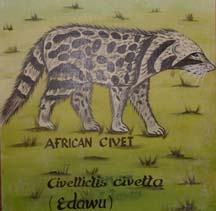 We
often discuss how the monkeys and other jungle resources can be saved when
illegal hunting is the way many villagers make a living. We speculate about
other alternatives, which would provide villagers with money and food while
still protecting the plants and animals.
We
often discuss how the monkeys and other jungle resources can be saved when
illegal hunting is the way many villagers make a living. We speculate about
other alternatives, which would provide villagers with money and food while
still protecting the plants and animals.